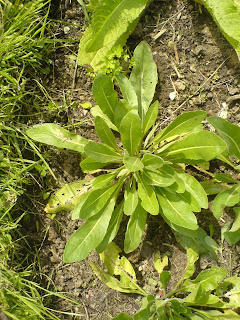About this blog space
This blog space is a place for me to primarily put all my wool gatherings, adventures, experiments. I am now a mum of two astounding daughters, and I used to be a DIY musician and co-ran a tiny independent label (Slampt), so this punk can-do attitude plus feminist analysis and Art school experience somehow informs my wool work! I am also deeply moved by GREEN, trees, weather, colour combinations in nature, and texture. I aim to source wool from round the corner or at the very least UK grown and processed, and to create no toxic waste. This means I get to see sheep as often as I can, sometimes at wool fests.
I am on Ravelry and Etsy as FatHenWildWool and Facebook as Rachel Holborow.
I am on Ravelry and Etsy as FatHenWildWool and Facebook as Rachel Holborow.
Wednesday, 3 October 2012
Woad, wonderful woad... growing and dyeing
So, the harvest has yielded!
This was my first year growing woad, and look at the lovely colour I got for my urine/ woad hot box combo ( see older posts for using this method ).
As blue is such a difficult natural dye colour to get, I decided to grow some this year from seed. I also know exactly where they came from (really local!) and there were no petrol transport miles involved in this process at all! I was donated the seed via a friend's mother, but also bought some on line.
One of the wonderful things about woad, is that you can harvest it in the first year of growth, in fact you need to, to get lovely blues, so the results are as quick as they can be!
I started growing these woad plants in February, as they really seem to need some frosty cold to germinate properly. Some seeds were sown directly into the ground, some were started off in little pots in my back yard. By the time it came to harvesting them ( any time from late August ), there was no difference in the size of either group of these plants, so either method is fine, but ofcourse, planting them in the ground first means , perhaps, one less process togo through ( although maybe more weeding?). Almost all the seeds germinated (hooray!), and a few leaves were a little munched here and there. In the end I had about 35 plants to harvest. One of them flowered, although woad is generally bienial in the UK (perhaps because some ants had decided to nest under it...). This plant is yet to bear fruit, so maybe might not this season, but an older plant I was donated has done, and I've harvested the black pendulous seeds from it, so hopefully can get a crop next year too.
It is the lovely lush green leaves you harvest, at a point in the year when they've had plenty of sun! Although this summer seemed very rainy, it was also rather sunny, and the proof is in this lovely blue I've obtained.
These leaves were harvested at the beginning of September, and brewed for two weeks in the warm urine vat. My harvest from the plants at this point was 1700 grams of leaves, and I used half of them for this brew, and reserved half of the dye liquid in (hopefully) airtight containers, for later use. This amount yielded about 300 grams of dyed fibres (mostly wool), from pale sky blues (one dip, or when the vat was running out) to a rather dark blue (from as many as 4 dips).
The green in the picture was a lovely yellow from birch leaves on a young jacobs wool fibres, that I overdyed with one dip in the woad vat.
Wenslydale locks came out a more royal blue than the blue faced leicester and shetland wool fibres. The really deep jeans blue was on soya silk fibres, but bamboo fibres came out much paler ( top left hand corner, on second photo). I also dyed some naturally grey and moorit shetland wool fibres: the blue only started to show after 3/4 dips, but I do like the effect too ( very top L hand corner, photo 2).
A month later, and I might be able to sneak one more harvest out of these plants before the cold darkness means they won't yield any more blue. If all turns out well, that might mean about 900 grams of fibres dyed from 35 plants.. We'll see how the saved dye liquid works out...
Finally, some photos of the lovely plants prior to harvest, they are about 6 inches in diameter...
And woad in flower, not to be harvested for blues apparently!
Labels:
bamboo fibres,
birch,
blue,
dyeing,
growing,
natural,
plant dyeing,
soya silk,
UK,
urine,
wensleydale,
woad,
yellow
Subscribe to:
Post Comments (Atom)





lovely colors. glad to know it is easy to grow. will be trying it next year.
ReplyDeleteSome people say It's too easy to grow, and regard it as a weed! In some countries it's regarded as invasive, and growing it is discouraged entirely. It does seed readily, so you may want to be careful where it sheds it's seeds..
DeleteThe growing is easy, it's the dyeing that's complex!
Hi, have you had any success using damsons for dyeing?
ReplyDeleteHi, have you had any success using damsons for dyeing?
ReplyDelete